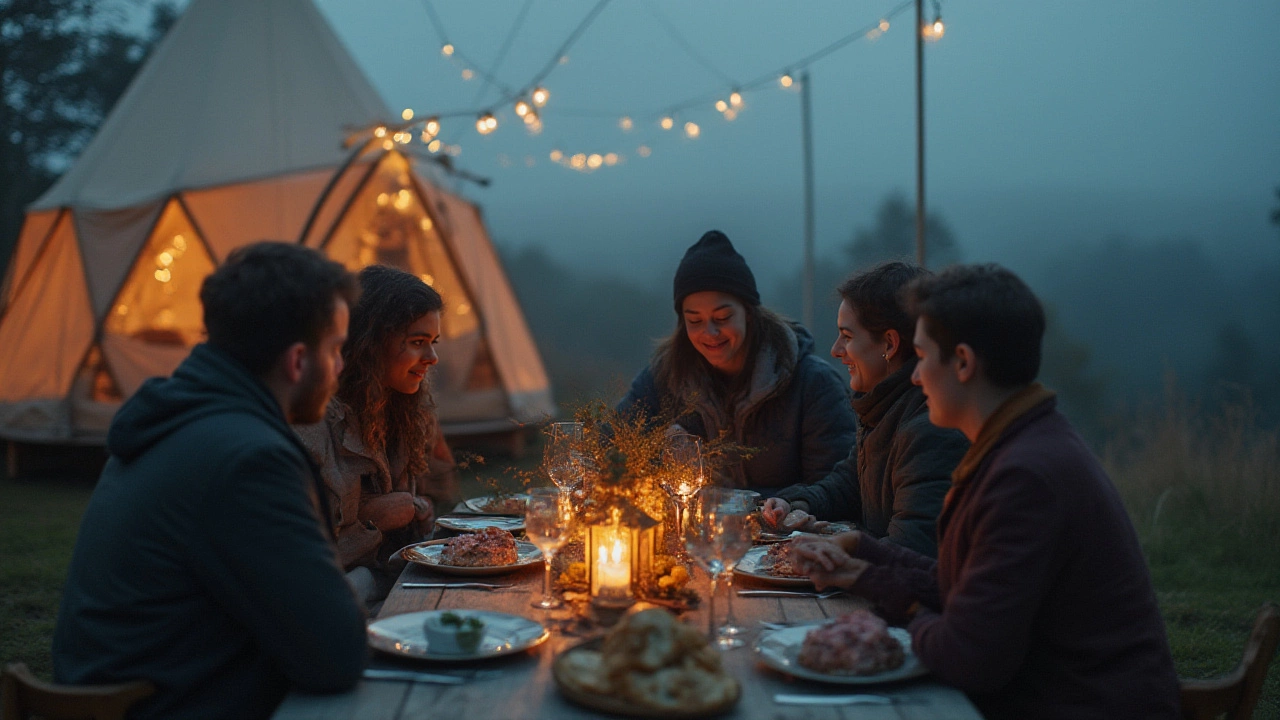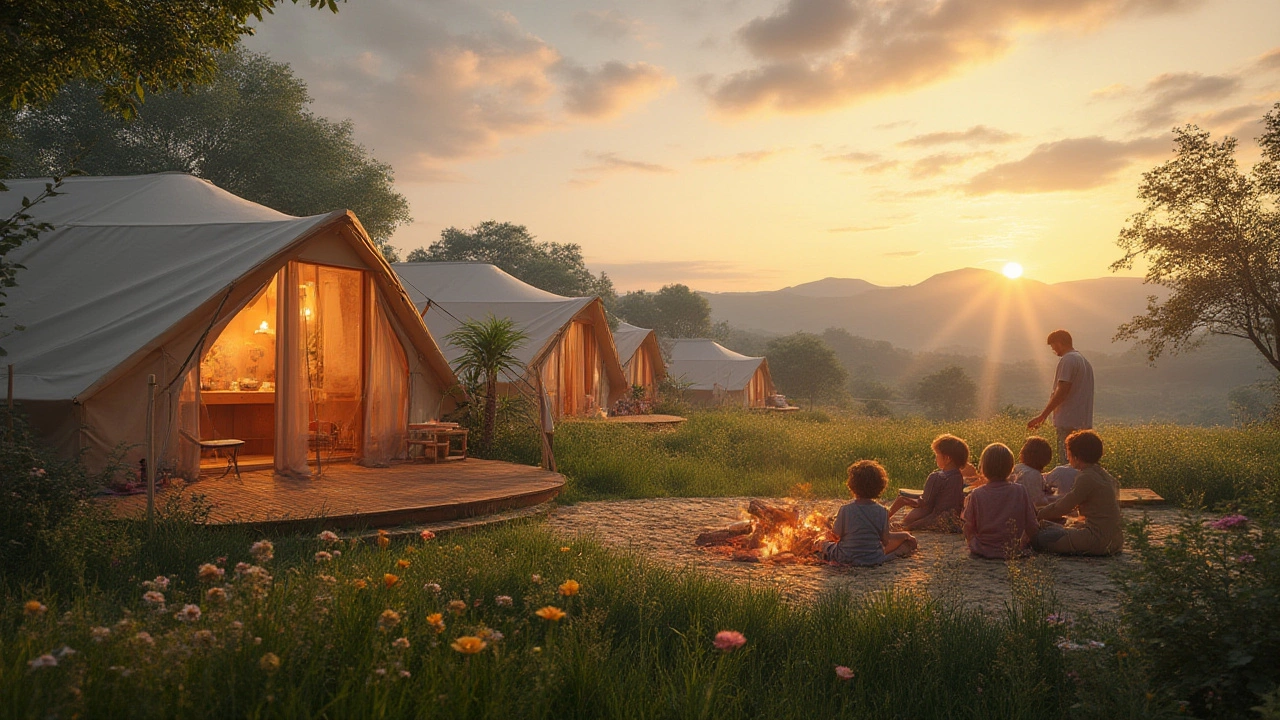Imagine waking up to birdsong and a cool breeze, but instead of fighting with damp tent flaps, you’re stretching out on a real mattress, gazing at the sky through a stylish canvas ceiling. That’s not just a lucky upgrade—welcome to glamping, where the wild comes with a side of comfort. Why bother with the rough parts of old-school camping when you’re after peace, nature, and the feel-good factor of the outdoors, but also crave real bedding, running water, and maybe a glass of wine by a crackling firepit? Is glamping just fancy camping, or is there more to the story?
Where Luxury and Nature Actually Meet
Let’s get this straight: glamping isn’t just about dropping a bed in a tent. This trend rose because so many people wanted nature—but not the hassle. Twenty years ago, if you wanted a wild escape you committed to packing sleeping bags; now, you can unpack in a safari lodge or a treehouse with WiFi. Glamping’s surge started around 2005 in the UK and took off worldwide, especially after the rise of Instagram—because sleeping under stars is even better with a king-sized pillow and a view worth posting. In 2023 alone, search volume for ‘glamping’ increased by 23% year-on-year in Europe, and the U.S. market value hit $3.7 billion, driven by families, couples, and even remote workers on 'workations.'
Think of glamping as the gateway drug to the outdoors for people who wouldn’t camp otherwise. You get direct access to wild lakes, forests, or mountains, but with sound-insulated walls and a bathroom you’d actually want to use. No, you don’t have to make do with canned beans either—many glamping set-ups boast gourmet kitchens or room service menus filled with local ingredients, plus a fire already built at check-in. That comfort means more people can share in the experience, including folks with young kids, mobility issues, or those who just aren’t into bugs and bad weather.
It isn’t just about being spoiled. When you’re not distracted by discomfort, you can actually soak in your surroundings. There’s something about sitting on a porch at dusk, hot coffee in hand, and watching deer graze nearby on a grassy field. It’s restful and recharging—some say it even helps you sleep better. That’s probably why glamping sites from New Zealand to Norway often fill up months ahead for prime summer weekends. Want to see the numbers? Here’s how the top features stack up around the globe:
| Glamping Feature | Percentage of Sites Offering |
|---|---|
| Private bathrooms | 86% |
| Real beds (not sleeping bags/cots) | 92% |
| Electricity and heating | 68% |
| Hot tubs/soaking tubs | 35% |
| Private kitchens | 52% |
So while it might sound like indulgence, the combo of modern conveniences and wild spaces is what fuels glamping’s unstoppable appeal. It’s the answer for everyone who’s ever said, “I’d go camping, but...” and then listed any number of valid complaints that glamping was made to solve.
The Surprising Health and Wellbeing Perks
The real magic of glamping? Honestly, it’s how good you feel afterwards. Plenty of hardcore campers will swear by the spartan life, but studies from universities in Finland and Canada have actually shown documented drops in stress hormones after even a short time spent in nature—regardless if you braved a rock bed or a feather mattress. So, you sleep better because the air’s clean. You eat better, usually farm-to-table or at least made in your own kitchen, and you actually want to spend time outdoors because you know a hot shower awaits.
One study published in the Journal of Environmental Psychology found that even city dwellers who don’t consider themselves 'outdoorsy types' see a 35% boost in mood after a weekend of ‘nature immersion,’ even if there’s never a tent pole in sight. Another benefit? Ditching technology. Sure, a lot of glampsites have WiFi if you want to upload photos or check in at work, but most see their guests spending nearly 70% less time on screens compared to a weekend in a city hotel. At first, you feel twitchy—then you start noticing the wind or the sound of frogs at night instead. "It makes me feel more alive—and less stressed," is the most common guest feedback, according to glamping operators from Cornwall to California.
Let’s talk about sleep. You might not realize how much your body craves a break from artificial lights, alarms, and blue screens until your main view is moonlight. People usually get to sleep earlier and wake up more rested. Melatonin (that’s the sleep hormone) gets back to its natural cycle. It’s not a miracle cure, but you can’t ignore how many return glampers chalk up their improved sleep, lower anxiety, and general mood boost to unplugging in the wild—just not in a way that makes their back ache for a week.
And for people who usually feel out of their comfort zone in the outdoors, glamping is like summer camp, but with an actual bed and coffee machine. You’ll find yourself trying new things—kayaking at sunrise, learning how to forage for wild herbs, or even just cooking your own pancakes on a wood stove without the stress. That sense of adventure is easy to find when you know there’s a hot tub waiting after you’re done.

Different Flavors of Glamping—What’s Out There?
If you thought glamping was just yurt after yurt lined up in a field, nope. The options are wild—and growing every year. Want to sleep in a vintage Airstream trailer, a Mongolian-style yurt, a treetop pod, or a glass igloo where you can watch the Northern Lights from bed? There’s a glampsite for it. Some even let you bring your dog along—my Max loves sniffing every inch of a new campsite almost more than I do. Just be sure to check pet policies ahead of time, as some sites are definitely more dog-friendly than others.
Here are the glamping styles you’ll run into:
- Safari tents: The original luxury canvas option, some even come with four-poster beds and real wood floors.
- Treehouses: Suspended among branches, complete with plumbing and often wrap-around decks for stargazing.
- Geodesic domes: Giant bubbles of clear or opaque fabric that can withstand serious wind or snow—incredible views guaranteed.
- Cabins and eco-lodges: More permanent structures, these often include real kitchens and fire pits. Many are built from sustainable wood.
- Tiny houses and airstreams: Perfect for road trip lovers who want a homey feel without needing to pitch a tent every night.
- Unusual stays: There are glamping sites shaped like giant wine barrels, converted airplanes, and even lighthouses, just to keep things interesting.
You might run into sites that look rustic but are cleverly built to be eco-friendly—think reclaimed wood, solar panels, composting toilets, or filtered greywater systems. Some spots will throw in extras like paddleboard rentals, cooking classes under the stars, or guided hikes so you’re not just sitting around, unless that’s your plan. A few even serve gourmet breakfasts on your private deck, which is a serious win for the non-morning people.
The real advice? Decide what matters most to you. Is it privacy? Go for a treehouse or cabin. Is it that Instagram aesthetic? Check out yurts or domes. Bringing your dog or your kids? Aim for spacious canvas tents in family-friendly campgrounds. The range is huge—there’s something for solo travelers wanting peace, couples after romance, and rowdy groups down for shared adventure (and maybe marshmallows at midnight).
Insider Tips to Glamp Like a Pro
Ready to try glamping yourself? Here’s what to know. First, book early if you want the best dates or most unique spots. Popular weekends in summer and fall, especially around national parks or famous beauty spots, go fast. Try shoulder seasons—late spring or early autumn—when crowds thin out but the scenery is just as jaw-dropping.
Pack like you would for a cozy cabin getaway. Most glampsites provide bedding, towels, soap, and basics, but double-check. Bring layers, even if there’s heat or AC—nights in the wild usually swing cooler, and nothing says adventure like stepping out in misty morning air for coffee on the deck. A headlamp or flashlight isn’t a bad idea, especially if you want to sneak out to see a fox or just walk Max under the stars. Don’t forget snacks for late-night cravings, charge your camera or phone, and grab a solid book or card game. Sure, screens work here, but you’ll genuinely want to disconnect.
If you can, go for a site with a private deck, hot tub, or a view—they’re absolutely worth it for those Instagram posts and peaceful evenings. Onsite activities might cost extra, but things like canoe rentals, yoga sessions, or breakfast hampers usually run cheaper if booked ahead. Don’t assume every place is ‘no trace’—ask about recycling, composting, and how their energy works if sustainability matters to you.
Lastly, respect the wildlife and your peaceful neighbors—wild places aren’t party central, though you can make pretty good friends around a campfire. If you’re bringing a dog, check the leash rules and pack their favorite toys and bed so they settle in fast.
Is glamping for everyone? Frankly, yes—if you want wild places without wild discomfort. It’s camping for people who love the idea of sleeping in nature, but want their pillow just so and coffee hot in the morning. The point of glamping is simple: you connect with nature better when you’re genuinely rested, well fed, and up for adventure—not busy fighting the cold or swatting away bugs all night. Next time you need a break, skip the hotel, ditch the sleeping bag, and give glamping a go. Your back and your sanity will both thank you.

